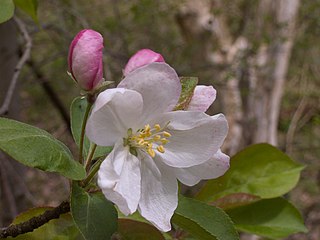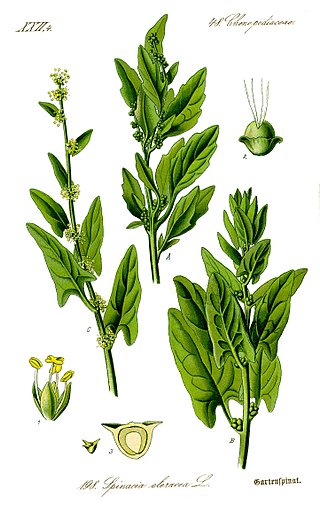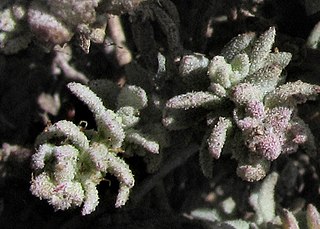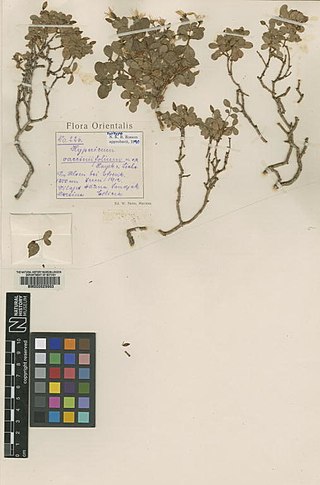
Podostemaceae, a family in the order Malpighiales, comprise about 50 genera and c. 300 species of more or less thalloid aquatic herbs.

Echinodorus, commonly known as burhead or Amazon sword, is a genus of plants in the family Alismataceae, native to the Western Hemisphere from the central United States to Argentina. Its scientific name is derived from Ancient Greek echius – "rough husk" - and doros – "leathern bottle" - alluding to ovaries, which in some species are armed with persistent styles, forming prickly head of fruit. Some of the species are commonly cultivated in artificial aquatic habitats.

Echinodorus macrophyllus is a species of aquatic plants in the Alismataceae. It is native to Brazil and Bolivia.

Malus coronaria, also known by the names sweet crabapple or garland crab, is a North American species of Malus (crabapple).
This page provides a glossary of plant morphology. Botanists and other biologists who study plant morphology use a number of different terms to classify and identify plant organs and parts that can be observed using no more than a handheld magnifying lens. This page provides help in understanding the numerous other pages describing plants by their various taxa. The accompanying page—Plant morphology—provides an overview of the science of the external form of plants. There is also an alphabetical list: Glossary of botanical terms. In contrast, this page deals with botanical terms in a systematic manner, with some illustrations, and organized by plant anatomy and function in plant physiology.

Grayia is a genus of plants in the subfamily Chenopodioideae of the family Amaranthaceae. Common names are siltbush and hopsage. The four shrubby species occur in arid and semiarid regions of western North America:
This glossary of botanical terms is a list of definitions of terms and concepts relevant to botany and plants in general. Terms of plant morphology are included here as well as at the more specific Glossary of plant morphology and Glossary of leaf morphology. For other related terms, see Glossary of phytopathology, Glossary of lichen terms, and List of Latin and Greek words commonly used in systematic names.
Erysimum siliculosum is a biennial or perennial herb from Xinjiang, Kazakhstan, Russia, and Turkmenistan, reaching 30-90 cm in height. It is closely related to Erysimum mongolicum. This species inhabits sandy areas and dunes from 400 to 1400 m of altitude.

Spinacia is a flowering plant genus in the subfamily Chenopodioideae of the family Amaranthaceae. The most common member is spinach.

Extriplex is a plant genus in the subfamily Chenopodioideae of the family Amaranthaceae. It has been described in 2010 and comprises two species, that were formerly included in genus Atriplex. They are restricted to the California Floristic Province.

Goldbachia is a genus of flowering plants belonging to the family Brassicaceae.
Hypericum acmosepalum is a dwarf shrub in Hypericumsect. Ascyreia that is native to China and known as jian e jin si tao locally.

Sida spenceriana is a small plant in the family Malvaceae found in Queensland, the Northern Territory and Western Australia

Hypericum vacciniifolium is a species of flowering plant in the flowering plant family Hypericaceae. It was first described by August von Hayek and Walter Siehe in the Ann. K. K. Naturhist. Hofmus. journal in 1914 from a specimen collected by Siehe in 1912.

Bredia is a genus of plants in the family Melastomataceae. Species in this genus are characterized by papery leaf texture and persistent and enlarged ovary crown, enclosing an inverted frustum-shaped depression at capsule top. This genus includes at least 21 species, 15 distributed in mainland China, one in north Vietnam, five in Taiwan and one extending to the Ryukyu Islands.
Pieter van Royen (1923-2002) was a Dutch botanist. He is an author of many papers on the flora of New Guinea.
Zehnderia is a monotypic genus of flowering plants belonging to the family Podostemaceae. It only contains one known species, Zehnderia microgyna.

Itoa is a genus of flowering plants in the family Salicaceae. It is also in the tribe Saliceae.

In botany, floral morphology is the study of the diversity of forms and structures presented by the flower, which, by definition, is a branch of limited growth that bears the modified leaves responsible for reproduction and protection of the gametes, called floral pieces.
Noveloa is a genus of aquatic flowering plants in the family Podostemaceae. Species of the genus are distributed across north and west Mexico in seasonally dry tropical areas, and plants are found in shallow, clear, fast-flowing rivers.













